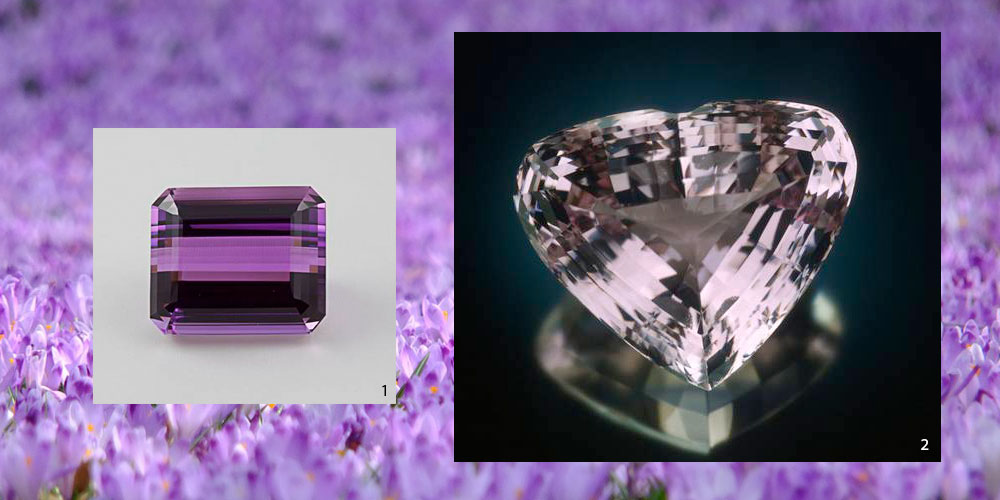Kunzite

Millions of years ago, deep in the bowels of our Earth, gemstones were created in innumerable variations.
We are familiar with most of them, and indeed we have been so in most cases for thousands of years. Yet every now and again a previously unknown variant of a gem comes to light.
One of these 'young' gemstones is kunzite, with its delicate pink hues, a gem which is seen more and more often nowadays, making an attractive eye-catcher in jewellery. Yes, kunzite has only been known for a little more than a hundred years, and yet it is now going through something like a second renaissance.
As we have already said, kunzite is still a very young gemstone. It was not until 1902 that the New York jeweller and gemstone specialist George Frederick Kunz (1856 – 1932) became the first person to give a comprehensive description of this stone, which had just been discovered in California. And since newly discovered gemstones are usually given the name of their discoverer or patron, this new pale pink discovery was called 'kunzite'.
Above all, the appeal of this gemstone lies in its clarity and its fine delicate pink nuances which often display a hint of violet. These are delicate, tender hues, feminine and seductive. In order to make sure that the fine colour is shown to its full advantage, the cutter must align the raw crystal very precisely during his work. The reason is that depending on the angle from which you look at a kunzite, it can appear violet, pink or even colourless. Indeed some kunzites from finds in Afghanistan display a rich, strong violet, a light violet and a light green depending on the angle of observation.
In gemmology, this phenomenon is known as pleochroism, the meaning of which equates to 'multi-colouredness'. This property is particularly well developed in kunzite. If you have the opportunity to look at a kunzite from close up, watch out for it. In a well cut stone, the most beautiful colour nuance will always be visible from above, experienced cutters working the raw crystal in perfect accord with its material properties. Most kunzites, however, have a fairly light colour. Strongly coloured kunzite is rare and thus correspondingly valuable.
This gemstone is the youngest member of the spodumen family, to which the green or yellowish-green hiddenite, discovered about a quarter of a century earlier, also belongs. Hiddenite too bears the name of its discoverer, W. E. Hidden. Those who are interested in gemmology will know that, together with diopside, jadeite and three other kinds of mineral, the spodumens make up the pyroxene group, the word pyroxene being derived from the Greek words pyr (fire) and xenos (stranger).
Pale pink kunzite was discovered in 1902 in the Pala District of San Diego County in California. Today, the prism-shaped crystals with their typical vertical striations are mainly found in Afghanistan, Madagascar, Brazil and the USA. The crystals, or fragments of crystals, often badly eaten away, can attain sizes of up to several kilogrammes.
As a variety of spodumen, kunzite belongs to the class of the chain silicates. It has minute traces of manganese to thank for its fine lilac colour. However, the colour can fade in direct sunlight. For that reason, jewellery with kunzite should never be worn while sunbathing or on the beach.
Its hardness is fairly good, between 6.5 and 7 on the Mohs scale. To the chagrin of the cutters, however, this gem has perfect cleavage and is thus extremely difficult to cut. Having said that, once it has been given its final shape, it becomes uncomplicated. But it is very difficult to re-cut. Cut kunzite surprises even experts again and again with its brilliance. The silvery gloss on its facets forms a beautiful contrast to the fine violet-pink of the gemstone.
In the trade, kunzite is available in many beautiful cuts. It is one of the gems which are available in relatively large sizes at affordable prices. When making a purchase, however, you should remember that it is first the colour and then the clarity which determines its value. The more intense the colour, the more valuable the kunzite. The question of whether the colour should tend more or less strongly towards violet will depend on your personal preference and skin type.
This gemstone with its fine, delicate pink is not only an ideal precious stone for lovers; it is also popular as a healing stone. Kunzite is said to enhance a person's capacity for devotion and understanding and to bestow inner peace and joie de vivre on its wearer. And since it is also said to activate the mind and liberate us from worry and anxiety, it is an excellent gemstone for those suffering from strain or exam nerves. Whether or not one actually believes in these positive effects, one thing is certain: its fine pink with a hint of violet radiates a serene composure and keeps moods of depression and anxiety at bay right from the outset. Try it for yourself!
Top image: 1. Photo by Ken Larsen, courtesy of The Smithsonian Institution Geo Gallery. 2. Photo by Chip Clark, courtesy of The Smithsonian Institution Geo Gallery.


